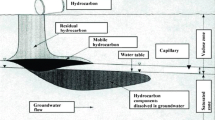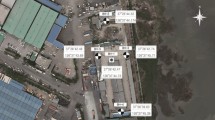Abstract
A study, aimed at characterizing the nature of anthropogenic and biogenic hydrocarbon contamination in the groundwater of Kuwait, was carried out using fluorescence spectroscopy and other analytical techniques. The results of these analyses have demonstrated that the groundwater in certain areas of northern Kuwait has been significantly impacted by contamination originating from the oil-contaminated surface soils. The study revealed that a water-soluble fraction (WSF) of the crude oil surface contamination appeared to be slowly leaching into the freshwater lenses located in the area. The study also showed that hydrocarbon pollutants were practically absent in the brackish water areas of central and southern Kuwait, except for a few isolated sites. However, nonpetroleum hydrocarbons, with ultraviolet-visible absorption characteristics and fluorescence characteristics typically associated with humic substances, were observed at a few sites in the brackish water fields.










Similar content being viewed by others
References
Aboul-Kassim TAT, Williamson KJ (2003) Forensic analysis and genetic source partitioning model for Portland Harbor contaminated sediments. J Environ Inform 58(1):58–75
Akber A, Viswanathan MN, AlSenafy M, Rashid T (2002) Assessment of long-term pollution potential for the groundwater of Raudhatain and Umm Al-Aish areas (Phase II). Kuwait Institute for Scientific Research, Kuwait, Report No. KISR6451
Al-Awadi E, Mukhopadhyay A, Quinn MF, Saeed T, Hauser A (2001) A preliminary investigation of the hydrocarbon content of groundwater of Kuwait. Environ Geol 41(3–4):330–340
Dudelzak AE, Babichenko SM, Poryvkina LV, Saar KJ (1991) Total luminescence spectroscopy for remote laser diagnostics of natural water conditions. Appl Opt 30(4):453–458
Farrell-Jones J (2003) Petroleum hydrocarbons and polyaromatic hydrocarbons. In: Thompson CK, Nathanail PC (eds) Chemical analysis of contaminated land. Blackwell, Oxford, pp 132–176
Filippova EM, Chubarov VV, Fadeev VV, Abd Daedan T (1994) New possibilities of laser fluorescence spectroscopy for diagnostics of petroleum hydrocarbons in natural water. Presented in the Second Thematic Conference on Remote Sensing for Marine and Coastal Environments, New Orleans, Louisiana, January 31–February 2
Grimalt JO, Grifoll M, Solanas AM, Albaiges J (1991) Microbial degradation of marine evaporitic crude oils. Geochim Cosmochim Acta 55:1903–1913
Grimalt JO, Lopez JF (2005) Analysis of oil polluted water samples from Kuwait water. Report by the Department of Environmental Chemistry, Institute of Chemical and Environmental Research, Spanish Council for Scientific Research, 24 April 2005
Hsu CS, Dechert GJ, Robbins WK, Fukuda EK (2000) Naphthenic acids in crude oils characterized by mass spectrometry. Energy Fuels 14:217–223
Hughey CA, Rodgers RP, Marshall AG (2002) Resolution of 11000 compositionally distinct components in a single electrospray ionization Fourier transform ion cyclotron resonance mass spectrum of crude oil. Anal Chem 74:145–4149
Jovančićević B, Vrvić M, Schwarzbauer J, Wehner H, Scheeder G, Vitorović D (2007) Organic-geochemical differentiation of petroleum-type pollutants and study of their fate in Danube alluvial sediments and corresponding water (Pančevo Oil Refinery, Serbia). Water Air Soil Pollut 183:225–238
Lemke M, Fernández-Trujillo R, Löhmannsröben H-G (2005) In-situ LIF analysis of biological and petroleum-based hydraulic oils on soil. Sensors 5:61–69
Literathy P (2000) Polar and non-polar aromatic micro pollutants in water (drinking water) resources. Presented at the IWA 1st World Water Conference, Paris, 3–7 July 2000
Literathy P, Haider S, Samhan O, Morel G (1989) Experimental studies on biological and chemical oxidation of dispersed oil in seawater. Water Sci Technol 21:845–856
Literathy P, Morel G, Al-Baloushi A (1991) Environmental transformation, photolysis of fluorescing petroleum compounds in marine waters. Water Sci Technol 23:507–516
Literathy P, Quinn MF, Al-Otaibi AS (2006) Monitoring of petroleum-related environmental contamination using fluorescence fingerprinting. In: Proceedings CD of the Beijing IWA World Water Congress, China, 10–14 September 2006, Paper Id. No.614682
Löhmannsröben H-G, Roch Th, Schultze RH (1999) Laser-induced fluorescence (LIF) spectroscopy for in situ analysis of petroleum products and biological oils in soils. Polycyclic Aromatic Compounds 13(3):165–174
Lundegard PD, Sweeney RE (1999) Measurement of total petroleum hydrocarbon in groundwater: evaluation of non-dissolved and non-hydrocarbon fractions. In: Proceedings of the 6th international petroleum and environmental conference, University of Tulsa, Oklahoma, USA, pp 654–677
Lundegard PD, Knott JR (2001) Polar organics in crude oil and their potential impacts on water quality. In: Proceedings of the 2001 conference on petroleum hydrocarbons and organic chemicals in groundwater. National Ground Water Association, Westerville, pp 138–144
Mukhopadhyay A, Al-Awadi E, Azrag E, Rashid T, Al-Qallaf H, Ghoneim H (2004) Assessment of groundwater pollution from oil fires and evaluation of remedial procedures. Kuwait Institute for Scientific Research, Kuwait, Report No. KISR7434
Pollard SJT, Wittaker M, Risden GC (1999) The fate of heavy oil wastes in soil microcosms I: a performance assessment of biotransformation indices. Sci Total Environ 226:1–22
Quinn MF, Alemeddine O, Al-Awadi E, Mukhopadhyay A, Qabazard AM, Al-Rasheedi M, Ismael AJ (2002) The application of laser-induced fluorescence techniques for the measurement of hydrocarbons in the groundwater of Kuwait. Instrum Sci Technol 30(1):79–95
Ramos I, Fuentes M, Mederos R, Grimalt JO, Albaigés J (1989) Dissimilar microbial hydrocarbon transformation processes in the sediment and water column of a tropical bay (Havana Bay, Cuba). Mar Pollut Bull 20:262–268
ROPME (1999) Manual of oceanographic observation and pollutant analyses methods (MOOPAM), 3rd ed. Regional organization for the protection of the marine environment, Kuwait
Sierra MMD, Giovanela M, Parlanti E, Soriano-Sierra EJ (2005) Fluoresecence fingerprint of fulvic and humic acids from varied origins as viewed by single-scan and excitation/emission matrix techniques. Chemosphere 58:715–733
SMEC (2006) Results of the Five-Year Monitoring and Assessment Program. A final report (GD5.12, Vol 1), prepared for the Public Authority for Assessment of Compensation (PAAC) for Damages Resulting from Iraqi Aggression Against the State of Kuwait, November 2006
Viswanathan MN, AlSenafy MN, Mukhopadhyay A, Kodituwakku KAW, Al-Fahad K (1996) Assessment of long-term pollution potential for the groundwater of Raudhatain and Umm Al-Aish areas (Phase I). Kuwait Institute for Scientific Research, Kuwait, Report No. KISR5006
Weisman W (1998) Analysis of petroleum hydrocarbons in environmental media. In: Total petroleum hydrocarbon criteria working group series, vol 1. Amherst Scientific Publishers, Amherst, 98p
Zemo DA, Foote GR (2003) The technical case for eliminating the use of the TPH analysis in assessing and regulating dissolved petroleum hydrocarbons in groundwater. Groundw Monit Remediat 23(3):95–104
Acknowledgments
The financial grants from the Environmental Protection Authority (EPA) of Kuwait and the Kuwait Foundation for the Advancement of Sciences (KFAS) made the study possible. The Groundwater Production Department of the Ministry of Electricity and Water (MEW), Kuwait, provided field support in the collection of the water samples. Mr. Habib Al-Qallaf, Mr. Tariq Rashid and Mr. Bandar Al-Salman carried out the field sampling. Mr. Harish Bhandary and Ms. Fatma Al-Marzouk carried out the laboratory analyses. The Central Analytical Laboratory and the Advanced System Department assisted in the GC, HPLC and fluorescence fingerprinting analyses. The expert advice from Dr. Peter Literathy, Senior Advisor, Kuwait Institute for Scientific Research (KISR) is very much appreciated. The managements of EPA and KISR are gratefully acknowledged for granting permission for the publication of the paper (Publication No. KISR8734).
Author information
Authors and Affiliations
Corresponding author
Rights and permissions
About this article
Cite this article
Al-Awadi, E., Quinn, M., Mukhopadhyay, A. et al. Extent and nature of hydrocarbon occurrence in the groundwater of Kuwait. Environ Geol 56, 877–889 (2009). https://doi.org/10.1007/s00254-008-1188-1
Received:
Revised:
Accepted:
Published:
Issue Date:
DOI: https://doi.org/10.1007/s00254-008-1188-1




